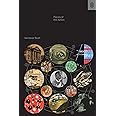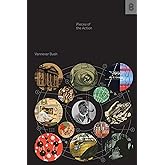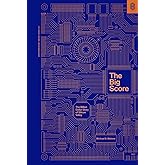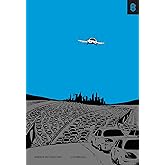
Enjoy fast, free delivery, exclusive deals, and award-winning movies & TV shows with Prime
Try Prime
and start saving today with fast, free delivery
Amazon Prime includes:
Fast, FREE Delivery is available to Prime members. To join, select "Try Amazon Prime and start saving today with Fast, FREE Delivery" below the Add to Cart button.
Amazon Prime members enjoy:- Cardmembers earn 5% Back at Amazon.com with a Prime Credit Card.
- Unlimited Free Two-Day Delivery
- Streaming of thousands of movies and TV shows with limited ads on Prime Video.
- A Kindle book to borrow for free each month - with no due dates
- Listen to over 2 million songs and hundreds of playlists
- Unlimited photo storage with anywhere access
Important: Your credit card will NOT be charged when you start your free trial or if you cancel during the trial period. If you're happy with Amazon Prime, do nothing. At the end of the free trial, your membership will automatically upgrade to a monthly membership.

Download the free Kindle app and start reading Kindle books instantly on your smartphone, tablet, or computer - no Kindle device required.
Read instantly on your browser with Kindle for Web.
Using your mobile phone camera - scan the code below and download the Kindle app.



 Audible sample
Audible sample Follow the authors
OK
Boom: Bubbles and the End of Stagnation

Explore your book, then jump right back to where you left off with Page Flip.
View high quality images that let you zoom in to take a closer look.
Enjoy features only possible in digital – start reading right away, carry your library with you, adjust the font, create shareable notes and highlights, and more.
Discover additional details about the events, people, and places in your book, with Wikipedia integration.
Purchase options and add-ons
“Read this book for the alternative history of our age.”
—Peter Thiel, investor and author of Zero to One
“A must-read for those who seek to build the future.”
—Marc Andreessen, cofounder of Netscape and Andreessen Horowitz
From the Moon landing to the dawning of the atomic age, the decades prior to the 1970s were characterized by the routine invention of transformative technologies at breakneck speed. By comparison, ours is an age of stagnation. Median wage growth has slowed, inequality and income concentration are on the rise, and scientific research has become increasingly expensive and incremental.
Why are we unable to replicate the rate of progress of past decades? What can we do to reinvigorate innovation?
In Boom, Byrne Hobart and Tobias Huber take an inductive approach to the problem. In a series of case studies tracking some of the most significant breakthroughs of the past 100 years—from the Manhattan Project and the Apollo program to fracking and Bitcoin—they reverse-engineer how transformative progress arises from small groups with a unified vision, vast funding, and surprisingly poor accountability. They conclude that financial bubbles, while often maligned as destructive and destabilizing forces, have in fact been the engine of past breakthroughs and will drive future advances. In other words: Bubbles aren’t all bad.
Integrating insights from economics, philosophy, and history, Boom identifies the root causes of the Great Stagnation and provides a blueprint for accelerating innovation. By decreasing collective risk aversion, overfunding experimental processes, and organizing high-agency individuals around a transcendent mission, bubbles are the key to realizing a future that is radically different from the present. Boom offers a definite and optimistic vision of our future—and a path to unleash a new era of global prosperity.
- ISBN-101953953476
- ISBN-13978-1953953476
- PublisherStripe Press
- Publication dateNovember 19, 2024
- LanguageEnglish
- Dimensions6.22 x 1.1 x 9.21 inches
- Print length304 pages
Discover the latest buzz-worthy books, from mysteries and romance to humor and nonfiction. Explore more
Frequently bought together
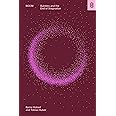
Customers who viewed this item also viewed
From the Publisher

Praise for Boom

The alternative history of our age.
“The dot-com bubble looked like the peak of delusion, but the truly deluded were those who wanted to indefinitely defer the future. Everyone knows bubbles can disguise madness as wisdom; read this book for the alternative history of our age.”
—Peter Thiel, investor and author of Zero to One

For those who seek to build the future.
“Boom makes the case that humanity's greatest risk is not climate change or misaligned superintelligent Al but not making enough progress. A must-read for those who seek to build the future.”
—Marc Andreessen, cofounder of Netscape and Andreessen Horowitz

Bubbles can drive progress.
"When is it that temporary bubbles can help drive forward progress? This happened with the railroads, with the internet, and it is likely to happen with AI. Byrne Hobart and Tobias Huber have produced some essential reading on a very important and also understudied topic."
—Tyler Cowen, author of The Great Stagnation and professor of economics at George Mason University

About the author
Byrne Hobart is an investor, consultant, and writer. He is the author of The Diff, a daily newsletter covering inflection points in finance and technology. He is also a founding partner at Anomaly, a frontier tech investment firm.

About the editor
Tobias Huber is a writer and investor. He is a founding partner at Anomaly, a frontier tech investment firm. He has a background in philosophy and holds a doctor of science degree from ETH Zurich.

About the publisher
Stripe Press publishes ideas for progress in science, technology, and economics. Our collection includes new ideas from emerging and established thinkers and industry leaders, as well as reimagined editions of enduring works. We curate our titles for a global audience of builders and practitioners who are shaping the future of policy and industry.
Stripe Press is based in South San Francisco, with team members across the US and in London. We are a part of the global payments infrastructure company Stripe.
Recent titles by Stripe Press:
- Poor Charlie's Almanack by Charles T. Munger and Peter D. Kaufman
- Scaling People by Claire Hughes Johnson
- Pieces of the Action by Vannevar Bush
Editorial Reviews
Review
“The dot-com bubble looked like the peak of delusion, but the truly deluded were those who wanted to indefinitely defer the future. Everyone knows bubbles can disguise madness as wisdom; read this book for the alternative history of our age.”—Peter Thiel, investor and author of Zero to One
“Boom makes the case that humanity's greatest risk is not climate change or misaligned superintelligent Al but not making enough progress. A must-read for those who seek to build the future.”—Marc Andreessen, cofounder of Netscape and Andreessen Horowitz
"When is it that temporary bubbles can help drive forward progress? This happened with the railroads, with the internet, and it is likely to happen with AI. Byrne Hobart and Tobias Huber have produced some essential reading on a very important and also understudied topic."—Tyler Cowen, author of The Great Stagnation and professor of economics at George Mason University
About the Author
Tobias Huber is a writer and investor. He is a partner at Anomaly, a frontier tech investment firm. He has a background in philosophy and holds a doctor of science degree from ETH Zurich.
Product details
- Publisher : Stripe Press (November 19, 2024)
- Language : English
- Hardcover : 304 pages
- ISBN-10 : 1953953476
- ISBN-13 : 978-1953953476
- Item Weight : 1.63 pounds
- Dimensions : 6.22 x 1.1 x 9.21 inches
- Best Sellers Rank: #12,210 in Books (See Top 100 in Books)
- #6 in Philosophy (Books)
- #16 in Theory of Economics
- #93 in Entrepreneurship (Books)
- Customer Reviews:
About the authors

Discover more of the author’s books, see similar authors, read book recommendations and more.

Tobias Huber is a writer and investor. He is a partner at Anomaly, a frontier tech investment firm. He has a background in philosophy and holds a doctor of science degree from ETH Zurich.
Customer reviews
Customer Reviews, including Product Star Ratings help customers to learn more about the product and decide whether it is the right product for them.
To calculate the overall star rating and percentage breakdown by star, we don’t use a simple average. Instead, our system considers things like how recent a review is and if the reviewer bought the item on Amazon. It also analyzed reviews to verify trustworthiness.
Learn more how customers reviews work on AmazonTop reviews from the United States
There was a problem filtering reviews right now. Please try again later.
- Reviewed in the United States on December 20, 2024The genre of sociology of knowledge is filled with often fantastic tales of adventure drawn from science and industry. Society is facing an enduring problem that has finally reached is pique. All the wise men are gathered, reflecting on the Gordian knot. Meanwhile, through a concatenation of events a virtual unknown from a nameless hamlet emerges to rescue humanity. The Kuhnian story is a classic in the genre. However, we're left with potentially empty theme. Too much emphasis on the machinations of History erases the human actor (see also: War and Peace by Tolstoy).
But what if ideas create their own demand? That's the elementary thesis that these two authors offer. The shift from a concentration on the typical architecture that has built the cathedral of the sociology of knowledge from things to the intangible is as profound as it is desperately needed in our material age. Their opening and closing argument lay great emphasis on mankind's gift for a transcendent vision. The vision, driven by a consuming passion to press the boundaries of our literal frontier outward is not one than can be explained in a Mertonian manner. What makes a bold vision emerge and a bubble fill is a visceral yearning for a new experiential range. That passion cannot be explained with a typical regression model filled with economic inputs or stochastic historical events; it demands a sentient human actor consumed with an idea (that intangible non-material factor). And yes, that idea may indeed be inspired by search to see the face of God.
The toughest sell in the book is their running headlong into a defense of bubbles. Not to fear, they kindly offer a few identifiers to help the reader differentiate those that are pregnant with opportunity from those that are (at best) barren. Take their advice and avoid the temptation to buy the dip. Take the risk of joining Peter Thiel and Marc Andreessen on an intoxicating adventure with this enthusiastic vision.
- Reviewed in the United States on December 27, 2024The book presents a rational argument on why “bubbles” or excessive hype for a given concept lead to great long-term outcomes in society. Six examples of technological revolutions are used to back this argument — the Manhattan Project, the Apollo Program, computer chips, corporate R&D, fracking, & bitcoin. The book briefly touches on each example and presents well-written reasoning to why the argument stands true. If you’ve studied the history of modern technology, you likely know something about each of these advancements.
My main issue with the book is how often Peter Thiel is referenced. His name is mentioned at least once in every chapter, often more. Nothing is terribly wrong with this since he’s an intellectual thought leader on many topics. But it gave the impression that the entire book comes from the perspective of “what would Peter Thiel think” instead of a more diverse offering of inspiration from other brilliant thinkers throughout history.
So overall, I found this book to be a classic case of the Silicon Valley thought bubble completely ignoring the outside world. Was it interesting & entertaining? Sure. But the book wasn’t as rich and expansive as it could've been.
- Reviewed in the United States on November 21, 2024If the publisher (Stripe Press) and author names (Byrne Hobart and Tobias Huber) don't already speak for themselves — you've been missing out!
I have trouble deciding whether to first compliment the quality of the hardcover itself or the taste and attention to detail imbued within every nearly passage and citation, so you'll have to purchase it yourself to find out! Truly a multidisciplinary work of art.
- Reviewed in the United States on November 25, 2024This is a fundamentally optimistic book about the future. It argues that many great things are in-the-moment and at-the-margin irrational for individual steps and individual actors, and the solution is some external force, hype, "boom", etc. which makes it happen anyway -- being rational at the larger scale. Essentially, why do A, B, and C if each only make sense if the others are also successful, but betting everything that B and C will be done, going all-in on A (even if it has to be tried in multiple parallel ways, so only one method works) can make everything work. They give some great examples from technology and history (Manhattan project, Apollo, and fracking), show how these were enabled by being built during "booms", and the positive results. It's interesting that the naive response to the boom/bust cycle of markets is that it's bad and one should sit them out, but many of the greatest investors (Warren Buffett) jump in as early as possible, and the cycle seems to be responsible for much of the progress in the world.
- Reviewed in the United States on January 7, 2025Coherence is not the only one thing missing in the book. Arguments have no true sources or data to back them, which are usually false, and with good narrative, turn false.
Often they use false past readings to make case for some thesis.
Finally, distortion of reality would easilly lead to a false hipothesis.
Finally, not much else to say, as everyone can see there is not a single event in tech that proves that stagnation is not the case in tech, rather than hyper growth, at the present , built mainly on AI.
I d prefer to listen to jensen Huang. Dont see any slowing eveolving, rather epic frowth and developments.
Top reviews from other countries
 Federico Quiros MalagonReviewed in Mexico on November 27, 2024
Federico Quiros MalagonReviewed in Mexico on November 27, 20245.0 out of 5 stars A must read for anyone interested in being a part of building the future
If you liked Zero to One, this book is for you. It opened my mind about the unintuitive positives of bubbles and gave me an appetite for taking more risks and having definite views about the future.












